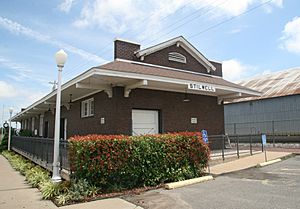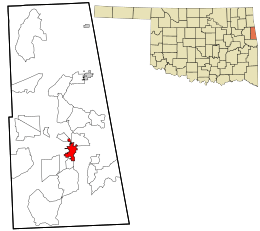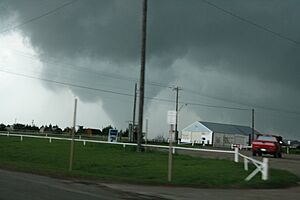Stilwell, Oklahoma facts for kids
Quick facts for kids
Stilwell, Cherokee Nation
ᏍᏗᎳᏪᎵ (Cherokee)
|
|
|---|---|

Defunct train station in Stilwell
|
|

Location within Adair County and the state of Oklahoma
|
|
| Country | United States |
| State | Oklahoma |
| County | Adair |
| Incorporated | 1897 |
| Named for | Arthur Stilwell (Stilwell) / Strawberries (ᏍᏗᎳᏪᎵ) |
| Government | |
| • Type | Mayor and council |
| Area | |
| • Total | 3.46 sq mi (8.95 km2) |
| • Land | 3.43 sq mi (8.89 km2) |
| • Water | 0.02 sq mi (0.06 km2) |
| Elevation | 1,083 ft (330 m) |
| Population
(2020)
|
|
| • Total | 3,700 |
| • Density | 1,077.77/sq mi (416.12/km2) |
| Time zone | UTC-6 (Central (CST)) |
| • Summer (DST) | UTC-5 (CDT) |
| ZIP code |
74960
|
| Area code(s) | 539/918 |
| FIPS code | 40-70350 |
| GNIS feature ID | 2411983 |
| Per capita income | $12,872 per year |
| Adult poverty rate | 37.2% |
| Child poverty rate | 49.0% |
| Website | cityofstilwell.com |
Stilwell (also known as ᏍᏗᎳᏪᎵ in the Cherokee language) is a city in the Cherokee Nation. It is also the main city, or county seat, of Adair County, Oklahoma. In 2020, about 3,700 people lived there. This was a small drop from 3,949 people in 2010.
In 1949, Oklahoma's governor and lawmakers called Stilwell the "Strawberry Capital of the World." However, strawberries are not as important to the local economy as they once were. Today, many families in Stilwell face financial challenges. Stilwell is also a good starting point to visit Lake Tenkiller and Adair Park.
Contents
History of Stilwell
The story of Stilwell began in 1838. It was an end point of the Trail of Tears. This was a sad time when thousands of Indigenous people were forced to move to the Stilwell area. In the Cherokee language, this trail was called nu na da ul tsun yi, meaning "the place where they cried."
In early 1839, the U.S. government set up a "disbandment depot" near what is now Stilwell. This depot gave food and supplies to the new arrivals. People with money soon moved to other parts of Indian Territory. But those who were sick or poor stayed near the depot for safety.
Early Settlers and Railways
In 1893, the U.S. government allowed American settlers to move into the Stilwell area. The Kansas City Southern Railway built a train line through the area in 1896. Because of this train line, the town grew quickly. Stilwell officially became a town on January 2, 1897. It was named after Arthur Stilwell, who started the Kansas City Southern Railway. By 1900, more white settlers lived there than Cherokee people.
Becoming the County Seat
As early as 1901, Stilwell and Westville both wanted to be the county seat. When Adair County was created in 1907, Westville was chosen. This was partly because it had two major railroads. However, after three close elections, Oklahoma Governor Charles Haskell announced Stilwell as the county seat on May 6, 1910.
World War II and Train Travel
During World War II in 1944, a prisoner of war (P.O.W.) camp was built about 5 miles (8 km) south of Stilwell. This camp held 200 soldiers from the Axis powers.
Stilwell used to have passenger train service. The Southern Belle train connected Stilwell to New Orleans and Kansas City. This service stopped on November 2, 1969. Another train, The Flying Crow, also stopped in town. The train station closed in 1971 because of damage. The building was fixed in 2004, but passenger trains did not return.
The Strawberry Capital
During the Great Depression, strawberries became a very important crop. They were a big part of the local economy. In 1948, the first strawberry festival was held. In 1949, the state governor called Stilwell the "Strawberry Capital of the World."
Over time, strawberry farming became less common. The number of farms growing strawberries went down. Even so, Stilwell still holds its strawberry festival every year. The 2015 festival had about 30,000 people. In 2022, the festival's parade was the biggest ever, with over 100 floats.
Geography of Stilwell
Stilwell is about 8 miles (13 km) west of the Arkansas state line. It is also 23 miles (37 km) east of Tahlequah, Oklahoma. The city is located where U.S. Highway 59 and State Highway 51 meet. Sallisaw and Little Lee creeks are close by.
The city covers about 3.2 square miles (8.3 km2). Most of this area is land, with a small amount of water.
Earthquakes and Soil
Earthquakes are sometimes felt in Stilwell. These quakes are often caused by oil and gas drilling in central Oklahoma.
Stilwell's soil is good for growing strawberries. It is rocky and acidic, which helps strawberries grow well. Below the ground, there is a type of rock called chert. This rock breaks down into the soil and is said to give the strawberries a special taste.
People of Stilwell
| Historical population | |||
|---|---|---|---|
| Census | Pop. | %± | |
| 1900 | 779 | — | |
| 1910 | 1,039 | 33.4% | |
| 1920 | 1,155 | 11.2% | |
| 1930 | 1,366 | 18.3% | |
| 1940 | 1,717 | 25.7% | |
| 1950 | 1,813 | 5.6% | |
| 1960 | 1,916 | 5.7% | |
| 1970 | 2,134 | 11.4% | |
| 1980 | 2,369 | 11.0% | |
| 1990 | 2,663 | 12.4% | |
| 2000 | 3,276 | 23.0% | |
| 2010 | 3,949 | 20.5% | |
| 2020 | 3,700 | −6.3% | |
| U.S. Decennial Census | |||
In 2020, 3,700 people lived in Stilwell. The number of people living there is slowly going down.
About 48% of the people are Indigenous, and about 42% are White. A small number of people are African American, Asian, or Pacific Islander. About 7% of the people are Hispanic or Latino.
There are about 1,269 households in Stilwell. About 35% of these households have children under 18. The average household has about 2.5 people. The average family has about 3.2 people.
The population is spread out by age. About 30% are under 18. About 15% are 65 or older. The average age in Stilwell is 32 years old.
Economy in Stilwell
Stilwell's economy faces challenges. Many residents have low incomes and a lower standard of living. Many families and children in Stilwell experience financial hardship.
The average income per person in Stilwell is about $12,872 per year. The average household income is about $31,637 per year (as of 2017). In 2017, about 37% of adults and 49% of children lived below the poverty line. More people in the town are facing financial difficulties. Also, about half of the residents do not have internet access at home.
Jobs and Industries
Farming has been the main part of the local economy for a long time. Strawberry farming was very successful during the Great Depression and World War II. At its best, the town had about 2,000 acres of land used for strawberries. Over time, the strawberry industry became less important. In 2022, only seven strawberry farms remained.
Ranching became important around 1960. Many local businesses grew from agriculture. Some employers included Tyson Foods, the Stilwell Canning Company, and Cherokee Nation Industries. As of 2022, the minimum wage in Stilwell is $7.25 per hour. For some workers, like students or farm workers, the minimum wage can be lower.
Education in Stilwell
Stilwell Public Schools teaches children from kindergarten through twelfth grade. There is one elementary school, one middle school, and one high school. After high school, students can study technical and vocational skills at the Indian Capital Technology Center campus in Stilwell.
For a short time, Stilwell had a private university called Flaming Rainbow University (1971-1989). It was created to help "Isolated Indians and rural whites" get an education. The university was named after a vision from a Sioux medicine man. This vision showed a rainbow, which stood for knowledge and its power. The university lost its official recognition in 1989 and closed.
Infrastructure and Transportation
Transportation in Stilwell
Airports
Painting Planes Airport is the main airport for small planes in Stilwell. It has one runway that is 1,084 feet (330 m) long. It is located 3 miles (5 km) southwest of town. The airport is not in good condition. It lacks basic tools like a wind cone. The runway markings are faded, and the surface has many cracks.
The closest airport for commercial flights is Northwest Arkansas National Airport (XNA). It is about 51 miles (82 km) northwest of Stilwell, in another state.
Highways
Stilwell is located where two main highways meet: U.S. Highway 59 and Oklahoma State Highway 51.
Walking and Cycling
There are very few places for people to walk in Stilwell. Most city streets do not have sidewalks. Only a few of the oldest streets downtown have them, and many are in poor condition. There are no paved paths outside of parks. Also, there are no special paths for bikes in the town. This means most errands require a car, according to Walk Score.
Public Transportation
There is a small, on-demand bus service in Stilwell. It is run by the KI BOIS Area Transit System. This service is open to everyone, but it is mainly used to give low-cost rides to older or financially struggling residents. There are no regular bus routes, long-distance buses, or passenger trains in Stilwell.
Railways
Stilwell is located on the main train line of the Kansas City Southern Railway. This line runs north and south through the east side of town.
Historic Places (NRHP Sites)
Several places in Stilwell are listed on the National Register of Historic Places. This means they are important historical sites. They include:
- The Adair County Courthouse, on Division Street
- Golda's Mill; its ruins are 12 miles northwest
- The KCS Railway Depot, off US Route 59
Notable People from Stilwell
- Sam Claphan, a Cherokee and former football player for the Oklahoma Sooners and San Diego Chargers.
- Frankie Hargis (1965–2021), a leader in the Cherokee Nation.
- Wanda Hatfield, a Cherokee Nation tribal councilor.
- Wilma Mankiller, the first female principal chief of the Cherokee Nation.
- Samuel Mayes, a principal Chief of the Cherokee Nation.
- Markwayne Mullin, a Republican U.S. senator.
See also
 In Spanish: Stilwell (Oklahoma) para niños
In Spanish: Stilwell (Oklahoma) para niños


